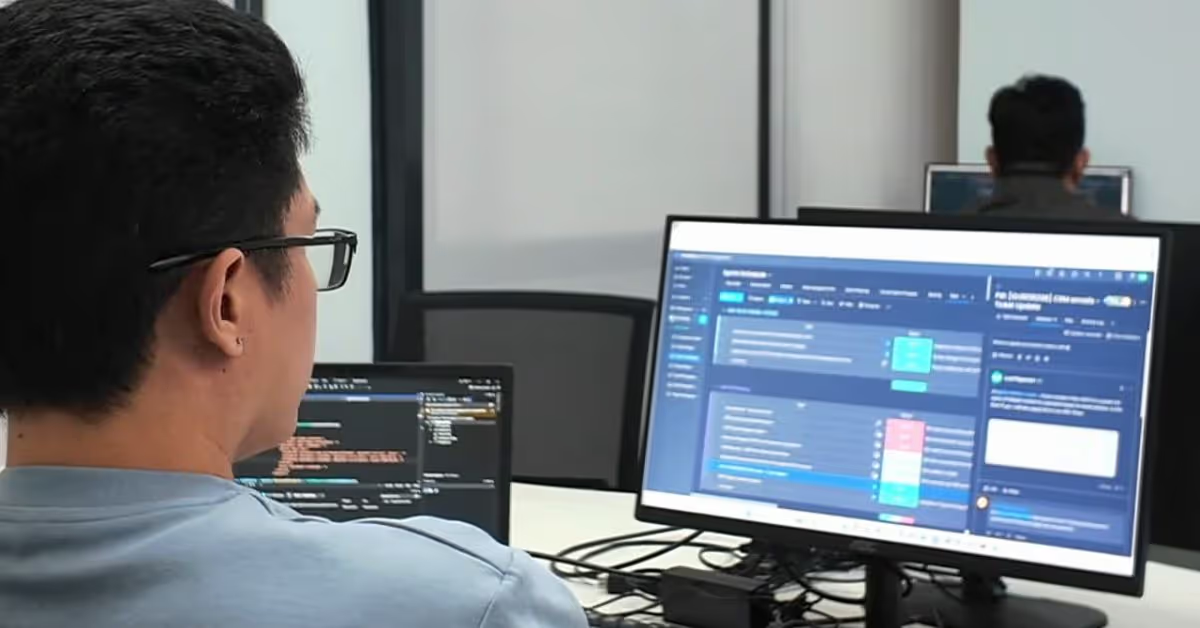Avoiding Burnout in Scaling Engineering Teams

📌 TL;DR
Burnout is one of the most significant risks when scaling engineering teams. Nearly half of developers report burnout during high-growth phases, which can derail delivery and damage culture. Leaders who succeed focus on clarity in goal setting, recognition for high performers, structured onboarding, and transparent communication. They balance workloads with staff augmentation, strengthen development processes, and support distributed teams. Cloud Employee brings expertise and support structures that allow businesses to scale their development teams while protecting engagement and sustaining performance.
Burnout in Engineering Teams
Burnout is one of the most significant risks for engineering teams during scaling. Developers who once thrived in small, fast-moving groups can feel overwhelmed when teams grow rapidly. Without the right leadership strategies, scaling undermines engagement, weakens delivery, and accelerates attrition. According to the 2024 State of Engineering Management Report, burnout is hitting engineers hard, with 65% saying they’ve experienced it in the past year. For senior leaders, avoiding burnout isn’t just about wellness; it’s a key performance strategy, it is a performance strategy. Sustainable scaling depends on keeping your people engaged, motivated, and supported.
Cloud Employee has partnered with fast-growing businesses across industries, helping them scale their development teams without exhausting their people. With 300+ developers supported by Talent Success Managers, L&D specialists, and Client Services Managers, Cloud Employee understands how to build systems that keep developers thriving during periods of change. This article outlines leadership strategies for scaling without burnout, combining people-centric insights with proven processes.
Setting Goals That Drive Alignment, Not Anxiety
Developers rarely burn out from clear goals, they burn out from constant shifting, unrealistic expectations, and misaligned priorities. The issue isn’t ambition, it’s clarity. Common challenges include:
- Unclear links between engineering work and business value: Engineers lose motivation when they can’t see impact.
- Confusion between strategy and execution: Teams drown in tactical tasks without visibility on long-term objectives.
- Top-down commitments without developer input: Unrealistic sprint goals erode trust and ownership.
At Cloud Employee, we’ve helped businesses around the globe overcome these hurdles by:
- Translating business advantage into achievable sprint goals with CTO-led vetting process, we ensure our engineers understand both delivery and strategy.
- Embedding transparency into workflows, ensuring strategic objectives are visible and tied to daily deliverables.
- Encouraging participatory planning, so engineers own commitments rather than viewing them as top-down pressure.
This approach has consistently improved engagement and reduced cognitive overload, with 97%+ of our developers retained beyond two years.
At Willo, what started as a way to extend capacity grew into a cultural partnership. Several Cloud Employee developers have now been with the company for over three years, giving the team not just technical continuity but also long-term alignment with Willo’s ethos.
One developer even went beyond delivery to host a company-wide masterclass, a passion project inspired by Willo’s founder. This illustrates how involving developers in goal-setting not only drives sustainable delivery but also unlocks cultural and commercial value far beyond code.
Recognizing and Retaining High Performers
Scaling often leans heavily on high performers, their productivity, mentoring capacity, and institutional knowledge. Without recognition and protection, these individuals are at greatest risk of burnout.
Leaders should:
- Acknowledge contributions, but tailor recognition to individual preferences.
- Provide leadership training and career pathways to show investment.
- Rebalance workloads so high performers are not unfairly burdened.
Recognition doesn't need to be grand gestures, something as simple as acknowledging excellence in a retrospective keeps motivation high.
Strengthening Development Processes for Scale
Strong processes are not bureaucracy, they are the foundation of scalable performance. What feels natural in a 10-person team quickly collapses when headcount doubles or triples. Without structure, delivery slows, mistakes multiply, and developers spend energy firefighting preventable issues.
According to Gartner, teams with a well-designed developer experience are 31% more likely to improve delivery flow and 20% more likely to remain with their employer (Gartner, 2024). This demonstrates a clear link between structured processes, sustained output, and retention.
For leaders, the priority is to implement processes that protect velocity without creating unnecessary overhead:
- Code reviews formalized to prevent rework while reinforcing shared standards.
- Sprint planning standardized to reduce scope creep and maintain delivery focus.
- Documentation treated as a strategic asset that accelerates onboarding and reduces knowledge silos.
- Automation leveraged to eliminate repetitive tasks and free engineers for higher-value problem-solving.
When these practices are neglected, growth introduces friction rather than scale. Developers can disengage, delivery slows, and attrition rises. When they are in place, teams sustain performance through periods of rapid change and retain the talent needed to keep scaling.
Leading Transparently in Uncertain Phases
Scaling inevitably brings ambiguity, shifting roadmaps, evolving priorities, tools under review. What truly undermines performance is silence, not uncertainty. Leaders who build trust through transparency not only reduce burnout, they raise output and engagement.
In a study of 25,285 employees, transformational leadership stood out as significantly correlated with higher engagement and lower burnout. When employees perceive their leaders as fair, clear, and motivating, performance improves. PLOS
Leaders should consider these steps to increase transparency and drive engagement:
- Share what’s known and what’s unknown immediately. Don’t wait for certainty to communicate. Let teams see priorities, risk areas, and trade-offs in play.
- Invite engineers into the decision matrix. Involvement in trade-offs over timeline, scope, tools gives them agency and aligns operational decisions with technical realities.
- Establish recurring feedback loops. Regular check-ins, retrospectives, or forums where concerns around burden, timelines, or processes can be surfaced early.
When leadership is transparent and trusted, developers report greater psychological safety, deliver more reliably under changing conditions, and burnout becomes far less likely. Trust accelerates performance; opacity erodes it.
Supporting Remote and Distributed Teams
Remote and distributed models unlock global talent, but they also introduce invisible risks. Without deliberate systems, developers can become disconnected from decision-making, lose sight of impact, and feel culturally isolated. These are precursors to burnout and attrition.
Research underscores the stakes: Deloitte’s 2024 Global Human Capital Trends report highlights that distributed teams are more likely to struggle with belonging and connection, factors that directly affect retention. Leaders who address these gaps not only protect well-being but also unlock the productivity advantages of distributed work.
Key practices to build a supportive environment for distributed teams include:
- Investing in structured communication rhythms. Beyond ad hoc messaging, set predictable cadences across time zones, such as overlapping stand-ups, weekly alignment sessions, and clear documentation trails, to prevent information gaps.
- Running inclusive agile ceremonies. Stand-ups, sprint reviews, and retrospectives should ensure equal participation across geographies. Simple practices like rotating facilitators or explicitly inviting remote voices prevent peripheral team members from being sidelined.
- Designing for connection, not just delivery. Deliberate cultural rituals, from virtual learning sessions to peer mentoring programs, strengthen trust and prevent distributed developers from becoming isolated task executors.
When distributed teams are fully integrated into workflows and culture, they don’t just avoid burnout, they outperform. Leaders who design systems of inclusion build resilience and retention, turning geographic diversity into a strategic advantage rather than a source of friction.
Extending Capacity Through Staff Augmentation
One of the most effective buffers against burnout is external capacity. Staff augmentation allows leaders to scale teams without overstretching core developers. Cloud Employee’s model ensures augmented developers integrate seamlessly into client workflows, while being supported by a dedicated structure that prevents overload and promotes engagement:
- Head of Learning & Development – Ensures engineers have continuous upskilling opportunities, reducing stagnation and keeping motivation high.
- Talent Success Manager – Works closely with both client and developer to flag early signs of overwork, adjust workload balance, and protect team health.
- Client Services Manager – Acts as a bridge between business goals and delivery, aligning expectations so engineers aren’t whipsawed by shifting priorities.
- HR Manager & Employee Experience – Maintains retention and morale by monitoring engagement, ensuring benefits, and providing a support system outside the immediate project team.
This structure means businesses gain capacity without exhausting their people. Developers remain supported by a professional network beyond the client team, which reduces isolation and spreads the weight of delivery. In many cases, external developers also introduce new practices and tools that benefit the entire team, without adding to the cognitive load of core staff.
When Salmon Software set out to launch a new SaaS platform, their in-house teams in Dublin and the Czech Republic were already fully stretched keeping existing systems running. Recruiting locally would have taken months and drained senior leaders’ time. By partnering with Cloud Employee, they onboarded 11 developers in just six weeks, spanning full stack, DevOps, and systems engineering.
The augmented team became a seamless extension of Salmon’s operations, supported by Cloud Employee’s Talent Success and HR managers to safeguard engagement and avoid burnout.
The result: Salmon accelerated SaaS delivery without disrupting core operations, expanded technical capabilities, and built a team that was both technically strong and culturally aligned. With ongoing support and retention above industry norms, Salmon now scales confidently without hiring bottlenecks or overloading its core developers.
CTO Marcus Kilgour even visited Manila to strengthen collaboration, noting:
Of all the outsourcing companies I've worked with in the past, Cloud Employee really impressed me because of all of their backend team: the Client Services team, the Welfare team, the HR team.
Best Practices to Prevent Burnout
- Measure software developer performance metrics alongside well-being indicators.
- Use augmentation to balance workloads during rapid scaling.
- Tailor recognition to the motivators of individual developers.
- Build soft skill training into leadership programs for project managers and product managers.
- Protect organizational culture by ensuring developers feel included, not replaced.
Final Thoughts: Growth Without Burnout
Scaling engineering teams creates pressure, but burnout is not inevitable. Leaders who combine realistic goal setting, authentic recognition, transparent communication, and structured augmentation create sustainable growth environments. For Cloud Employee, the mission is clear: give leaders access to top-class talent while ensuring systems of care keep both internal and external developers motivated.
Scaling is an opportunity to build trust, resilience, and stronger teams. Leaders who prevent burnout not only protect their people, they safeguard their business’s ability to grow.
Speak to Cloud Employee about scaling your engineering team. Contact us today.
FAQs
By setting clear goals, supporting remote teams, strengthening processes, and using external capacity strategically.
Because they absorb mentoring and delivery pressure during growth, requiring recognition and workload balance.
By providing augmented developers backed by HR, L&D, and engagement structures that spread workloads and keep staff motivated.






